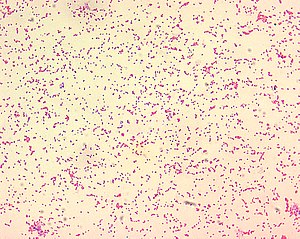Brucellen
| Brucellen | ||||||||||||
|---|---|---|---|---|---|---|---|---|---|---|---|---|

Brucella under the light microscope (Gram stain) |
||||||||||||
| Systematics | ||||||||||||
|
||||||||||||
| Scientific name | ||||||||||||
| Brucella | ||||||||||||
| Meyer & Shaw 1920 |
Brucella are short, rod-shaped bacteria of the genus Brucella . These gram-negative and aerobic bacteria are found in the urinary and reproductive systems of cows, sheep and pigs. Very rarely they can cause a generalized infection if transmitted to humans. That is why dairy products are pasteurized in most countries . Detection in the milk can be made using an Abortus Bang ring test .
The name honors the English military doctor David Bruce .
Taxonomy and systematics
Until 1986, numerous species were distinguished in the genus Brucella . On the basis of DNA family trees, efforts have been made to summarize them in just one species, Brucella melitensis . In practice, however, the old species classification was mostly retained. In 2003 the Subcommittee on the Taxonomy of Brucella therefore decided to return to the systematics from before 1986. They used to be collectively referred to as parvobacteria .
Currently (as of 2017) the following species are listed in the genus, B. melitensis is the type species .
- Brucella abortus ( Schmidt 1901) Meyer & Shaw 1920
- Brucella canis Carmichael & Bruner 1968
- Brucella ceti Foster et al. 2007
- Brucella inopinata Scholz et al. 2010
- Brucella melitensis ( Hughes 1893) Meyer & Shaw 1920
- Brucella microti Scholz et al. 2008
- Brucella neotomae Stoenner & Lackman 1957
- Brucella ovis Buddle 1956
- Brucella pinnipedialis Foster et al. 2007
- Brucella suis Huddleson 1929, causative agent of infectious abortion in pigs, rarely in humans
- Brucella papionis Whatmore, et al. 2014
- Brucella vulpis Scholz et al. 2016
Brucellosis
Pathogenesis
Through direct contact with sick animals or indirectly through contaminated food (especially unpasteurized milk). The pathogen penetrates through the mucous membranes and nests in phagocytes (micro- and macrophages). This transports them to lymph nodes , liver , spleen , bone marrow and other tissues, in whose cells they can survive and even multiply. The pathogens can spread into the blood in batches from these hiding places.
clinic
Brucella are the causative agents of brucellosis . After an incubation period of 1 to 4 weeks, after infection of the intestinal mucosa, spread via macrophages into the lymphatic system due to colonization of the lymph nodes , lymphadenitis occurs . From here there is a spread via the blood ( hematogenous ) and involvement of organs (especially liver, spleen, bone marrow) and the formation of granulomas there . Patients have attacks of fever, which can also be accompanied by chills. The progressive progression of the symptoms is caused by the release of the multiplying bacteria from the affected organs into the bloodstream and the stimulation of cytokines there .
Called by Brucella, including Bang bacteria , disease caused will undulant fever (Latin undulant fever ), Bang'sches fever , the pathogen Brucella melitensis Malta fever or the pathogen Brucella abortus Bang's disease (named after Bernhard Bang ) called.
Bioweapons
In the US , Brucellae are being studied in connection with biological weapons .
Reporting requirement
In Germany, the direct or indirect detection of Brucella sp. Specifically notifiable in accordance with Section 7 of the Infection Protection Act (IfSG), provided that the evidence indicates an acute infection. The obligation to notify primarily concerns the management of laboratories ( § 8 IfSG).
In Switzerland, the positive laboratory analysis results for Brucella spp. notifiable for laboratories and indeed after the Epidemics Act (EpG) in connection with the epidemic Regulation and Annex 3 of the Regulation of EDI on the reporting of observations of communicable diseases of man .
Web links
Individual evidence
- ^ A b Jean Euzéby, Aidan C. Parte: Genus Brucella. In: List of Prokaryotic names with Standing in Nomenclature ( LPSN ). Retrieved October 21, 2014 .
- ↑ Hans von Kress (ed.): Müller - Seifert . Pocket book of medical-clinical diagnostics. 69th edition. Published by JF Bergmann, Munich 1966, p. 1062.
- ^ Sloppiness in biological weapons laboratory withheld for months , Spiegel Online , July 3, 2007